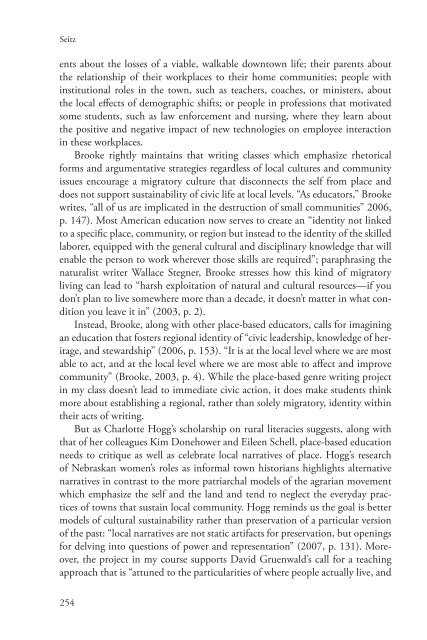Critical Expressivism- Theory and Practice in the Composition Classroom, 2014a
Critical Expressivism- Theory and Practice in the Composition Classroom, 2014a
Critical Expressivism- Theory and Practice in the Composition Classroom, 2014a
Create successful ePaper yourself
Turn your PDF publications into a flip-book with our unique Google optimized e-Paper software.
Seitz<br />
ents about <strong>the</strong> losses of a viable, walkable downtown life; <strong>the</strong>ir parents about<br />
<strong>the</strong> relationship of <strong>the</strong>ir workplaces to <strong>the</strong>ir home communities; people with<br />
<strong>in</strong>stitutional roles <strong>in</strong> <strong>the</strong> town, such as teachers, coaches, or m<strong>in</strong>isters, about<br />
<strong>the</strong> local effects of demographic shifts; or people <strong>in</strong> professions that motivated<br />
some students, such as law enforcement <strong>and</strong> nurs<strong>in</strong>g, where <strong>the</strong>y learn about<br />
<strong>the</strong> positive <strong>and</strong> negative impact of new technologies on employee <strong>in</strong>teraction<br />
<strong>in</strong> <strong>the</strong>se workplaces.<br />
Brooke rightly ma<strong>in</strong>ta<strong>in</strong>s that writ<strong>in</strong>g classes which emphasize rhetorical<br />
forms <strong>and</strong> argumentative strategies regardless of local cultures <strong>and</strong> community<br />
issues encourage a migratory culture that disconnects <strong>the</strong> self from place <strong>and</strong><br />
does not support susta<strong>in</strong>ability of civic life at local levels. “As educators,” Brooke<br />
writes, “all of us are implicated <strong>in</strong> <strong>the</strong> destruction of small communities” 2006,<br />
p. 147). Most American education now serves to create an “identity not l<strong>in</strong>ked<br />
to a specific place, community, or region but <strong>in</strong>stead to <strong>the</strong> identity of <strong>the</strong> skilled<br />
laborer, equipped with <strong>the</strong> general cultural <strong>and</strong> discipl<strong>in</strong>ary knowledge that will<br />
enable <strong>the</strong> person to work wherever those skills are required”; paraphras<strong>in</strong>g <strong>the</strong><br />
naturalist writer Wallace Stegner, Brooke stresses how this k<strong>in</strong>d of migratory<br />
liv<strong>in</strong>g can lead to “harsh exploitation of natural <strong>and</strong> cultural resources—if you<br />
don’t plan to live somewhere more than a decade, it doesn’t matter <strong>in</strong> what condition<br />
you leave it <strong>in</strong>” (2003, p. 2).<br />
Instead, Brooke, along with o<strong>the</strong>r place-based educators, calls for imag<strong>in</strong><strong>in</strong>g<br />
an education that fosters regional identity of “civic leadership, knowledge of heritage,<br />
<strong>and</strong> stewardship” (2006, p. 153). “It is at <strong>the</strong> local level where we are most<br />
able to act, <strong>and</strong> at <strong>the</strong> local level where we are most able to affect <strong>and</strong> improve<br />
community” (Brooke, 2003, p. 4). While <strong>the</strong> place-based genre writ<strong>in</strong>g project<br />
<strong>in</strong> my class doesn’t lead to immediate civic action, it does make students th<strong>in</strong>k<br />
more about establish<strong>in</strong>g a regional, ra<strong>the</strong>r than solely migratory, identity with<strong>in</strong><br />
<strong>the</strong>ir acts of writ<strong>in</strong>g.<br />
But as Charlotte Hogg’s scholarship on rural literacies suggests, along with<br />
that of her colleagues Kim Donehower <strong>and</strong> Eileen Schell, place-based education<br />
needs to critique as well as celebrate local narratives of place. Hogg’s research<br />
of Nebraskan women’s roles as <strong>in</strong>formal town historians highlights alternative<br />
narratives <strong>in</strong> contrast to <strong>the</strong> more patriarchal models of <strong>the</strong> agrarian movement<br />
which emphasize <strong>the</strong> self <strong>and</strong> <strong>the</strong> l<strong>and</strong> <strong>and</strong> tend to neglect <strong>the</strong> everyday practices<br />
of towns that susta<strong>in</strong> local community. Hogg rem<strong>in</strong>ds us <strong>the</strong> goal is better<br />
models of cultural susta<strong>in</strong>ability ra<strong>the</strong>r than preservation of a particular version<br />
of <strong>the</strong> past: “local narratives are not static artifacts for preservation, but open<strong>in</strong>gs<br />
for delv<strong>in</strong>g <strong>in</strong>to questions of power <strong>and</strong> representation” (2007, p. 131). Moreover,<br />
<strong>the</strong> project <strong>in</strong> my course supports David Gruenwald’s call for a teach<strong>in</strong>g<br />
approach that is “attuned to <strong>the</strong> particularities of where people actually live, <strong>and</strong><br />
254


















